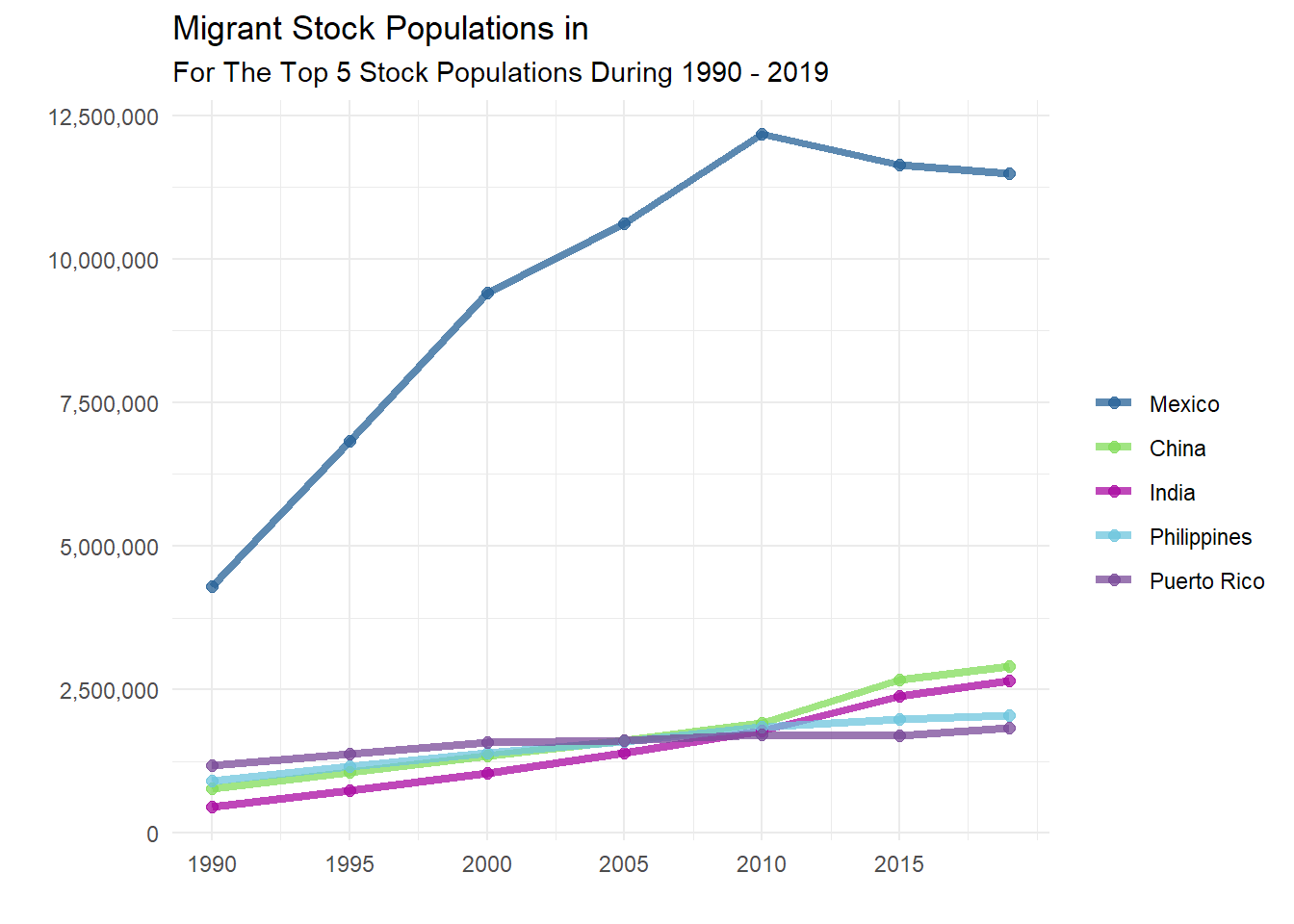Summary:
- Premier (possibly only?) data for migrant populations with global coverage.
- There is a limited time period 1990-2019 with 5 year intervals.
- Suffers from likely reporting biases and country to country inconsistencies.
The United Nations International Migrant is one of the premier datasets presenting global snapshots of dyadic migrant populations. The dataset records host country, stock country, and population size for 231 international countries and territories. Additionally, the United Nations provides dissaggregated datasets featuring populations broken down by age and sex. In contrast to the United Nations Populations of Concern dataset, there are a limited number of competing datasets. These include The World Bank Group’s Bilateral Migrant Stock Database,1 and The Organisation for Economic Co-operation and Development’s (OECD) database of immigrants and expatriates.2

Figure 1: Top 5 migrant stock populations in the United States between 1990–2019.
As one of the few sources of international migrant stock data it’s regularly featured in peer reviewed research and serves as a foundation for migration policy. Several recent manuscripts from Guy Abel that incorporate the migrant stock dataset have gained notoriety. Abel and Sander’s3 study Quantifying Global International Migration Flows utilized the migrant stock database to infer dyadic flows between countries. The dataset was recently the subject of an examination of female international migration by.4 The 2005 revision of the migrant stock database was featured in an analysis of social networks and migrant mobilization in Southern Europe.5
Although the migrant stock dataset is featured in numerous peer reviewed manuscripts and commissioned reports, it still suffers from persistent issues that plague many human geography and migration datasets. There may be underlying discrepancies between countries, due to varying reporting methodologies. These may include reporting intervals, legal definitions of migrant status, or an administration’s capacity to accurately report populations. Moreover, as a result of the sensitivity of migrant populations and individual status, population estimates are often under-reported.6
Reference
Citation Information:
- Title: Trends in International Migrant Stock: The 2019 Revision
- Edition: Version 2019
- Publication Date: 2020
- Data Form: tabular, country-year, wide form dyadic
- Publisher: The United Nations, Department of Economic and Social Affairs, Population Division
- Online Host: https://www.un.org/en/development/desa/population/migration/data/estimates2/estimates17.asp
- DANTE Citekey: TheUnitedNations2017a
Dataset Contact Information:
Office of the Director, Population Division, Department of Economic and Social Affairs, United NationsPablo Lattes, Population Division, Department of Economic and Social Affairs, United Nations
Bela Hovy, Population Division, Department of Economic and Social Affairs, United Nations
Use Constraints:
Non-commercial use permitted, distribution prohibited, other uses are restricted. Please see the United Nations Software Licence Agreement for further details.
Abstract:
The dataset presents estimates of international migrant by age, sex and origin. Estimates are presented for 1990, 1995, 2000, 2005, 2010, 2015, 2017, and 2019 are available for all countries and areas of the world. The estimates are based on official statistics on the foreign-born or the foreign population.
Additional Metadata
Time Period Information:
- Beginning Date: 1990
- Ending Date: 2019
- Resolution: quinquennial


Add new comment